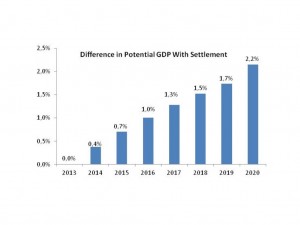Potential Growth Perspective on Settlement
- Posted by Pelin Dilek
- Posted on April 14, 2013
- Sustainable Development
- Comments Off on Potential Growth Perspective on Settlement
‘Cautious optimism’ seems to be the most popular word nowadays in Turkey. Now that politicians seem to be closer to allow peace to settle in the South East of Turkey, everybody is trying to understand what kind of changes the Country will go through after 30-year of chaos in the South Eastern Region. The debate is getting hotter as the rating agencies announce that ‘Turkey’s progress toward peace with Kurdish insurgents is credit positive’.
The general approach here is concentrating on what might Turkey save on military expenditures if it does need to suppress the terrorists. There is a bulk number that Turkey has spent US$ 300bn so far on such kind of expenditures. While it will be good not spend any money on guns etc., this number does not mean much to me because we have never seen those numbers in official budget figures anyway. Unless we use an assumption here that a portion of that money will be channeled to the budget, this approach does not yield any measurable economic optimism.
Another approach would be to pick out the regional winners of the Settlement. East and South East of Turkey where the majority is Kurdish origins, remains underdeveloped compared to the rest of Country. Both the economic and social indicators of the region, when compared to the average of Turkey, make it hard to believe that we are talking about the different regions of the same country. Gross value added of the region is approximately one third of Turkey’s average and one fourth of Istanbul. Labor participation rate is around 30% in the East and South East of Turkey compared to Turkey’s average of 48%. More shockingly, female labor participation rate is in the low 10%. While the Region makes up 17% of the population, it makes up 7% of the labor force (for simplicity reasons, the table shows two of the cities in the region). With such a low base, the region overall has a lot to benefit from the Settlement. Probably, some cities within the region will benefit more than the others. TEPAV’s Guven Sak wrote about this issue in ‘Why Kurdish politicians should start learning the language of development’.

Yet, I am more interested in what Settlement means for Turkey’s overall macro figures, especially potential growth rate: In order assess what Settlement might mean for the overall macro figures, I looked at one of the three sub-items of the potential growth rate calculations. Rather than taking different assumptions on all three factors (labor, capital and productivity), I drew a different scenario for the labor side assuming that Settlement will bring an improvement on the Region’s 30% labor participation rate and overall unemployment rate (according to Turkstat definition TRC1, TRC2, TRC3, TRB1 and TRB2 are included as the South East and Eastern Regions). The reasons why I chose labor as a changing variable are twofold:
1) For practical reasons, this was one variable that I could easily play with
2) As mentioned in the above paragraph, there is such a huge difference in the labor statistics between this Region and rest of Turkey that any kind of normalization in the Region is likely to make a difference
Taking everything else as constant, assumption here is that the Region’s labor participation rate (LPR) increases to 50% from the current 30% while the Turkey’s average rate increases to 58% by 2020. In the no-Settlement scenario, Turkey’s LPR is at 55% by 2020. In other words, increasing the East and South East Region’s LPR to 50%, makes an increase of 3% in Turkey overall rate. Also I have assumed that the difference between the unemployment rate of the Region and Turkey narrows down even though it does not completely close down by 2020.
Here are the results: Only by altering the regions labor participation and unemployment rate, Turkey’s potential growth increases by 2.2% by 2020. The 2.2% might not seem much at first glance but it should be underlined here that no productivity increases or capital increases have been included in this exercise.

Conclusion: Any Normalization Is Better Than No-Normalization…
If the Settlement brings about a ‘normalization period’ in the region, what we should expect is a gradual narrowing of the difference between the social and economic indicators of the Region with the rest of the Country. What this simple exercise here shows is that ‘because the difference in the economic and social indicators of Region with the rest of Turkey is so huge right now, it is impossible to think that any normalization would not have any impact on Turkey’s average figures’. And yet, how fast the difference closes and how much average Turkey numbers are affected will depend on the choice of economic policy and the capability of the politicians. And that, we will live and learn…
- March 2023
- February 2023
- September 2022
- April 2022
- February 2021
- June 2020
- March 2020
- December 2019
- November 2019
- June 2019
- May 2019
- March 2019
- February 2019
- October 2018
- August 2017
- June 2017
- February 2016
- October 2015
- May 2015
- March 2015
- January 2015
- December 2014
- September 2014
- April 2014
- January 2014
- December 2013
- November 2013
- October 2013
- September 2013
- July 2013
- May 2013
- April 2013
